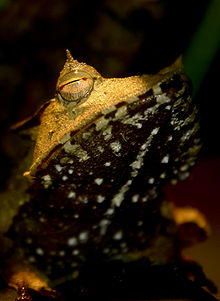Hemiphractus
| Hemiphractus | |
|---|---|
 |
|
| Hemiphractus fasciatus | |
| Scientific classification | |
| Kingdom: | Animalia |
| Phylum: | Chordata |
| Class: | Amphibia |
| Order: | Anura |
| Family: | Hemiphractidae |
| Genus: |
Hemiphractus Wagler, 1828 |
| Diversity | |
| 6 species (see text) | |
| Synonyms | |
|
Cerathyla Jiménez de la Espada, 1870 |
|
Cerathyla Jiménez de la Espada, 1870
Hemiphractus (known as horned (tree)frogs) is a genus of frogs in the family Hemiphractidae. They are found in northern South America and Panama.
Hemiphractus are robust-bodied frogs. The genus is characterized by a fleshy proboscis on terminus of snout and fleshy tubercles on eyelids, skull that is highly casqued with prominent lateral occipital processes projecting backwards, and fang-like maxillary and premaxillary teeth.
Female frogs carry eggs openly on their back; the eggs adhere to the mother's back with gelatinous material. Eggs hatch as fully developed froglets.
Hemiphractus are believed to be specialized predators of other frogs, and hence confined to areas with high density of frogs. They can threat their predators by opening their mouth, exposing the colourful tongue.
There are six recognized species:
...
Wikipedia
